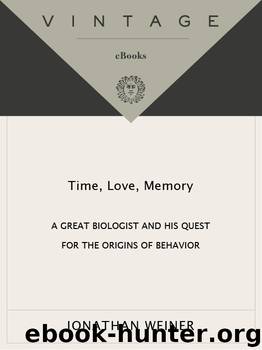Time, Love , Memory by Jonathan Weiner

Author:Jonathan Weiner [Weiner, Jonathan]
Language: eng
Format: epub
ISBN: 978-0-8041-5336-2
Publisher: Knopf Doubleday Publishing Group
Published: 2014-05-13T16:00:00+00:00
CHAPTER TWELVE
Cloning an Instinct
No doubt the process of decipherment was difficult, but only by accomplishing it could one arrive at whatever truth there was to read.
—MARCEL PROUST,
Time Regained
THE MOST DIRECT WAY to clone a fly gene is to take a needle and cut it right out of one of the giant chromosomes in the fly’s salivary glands. These are chromosomes that carry extra copies of each gene: hundreds of copies side by side, so many that through the microscope each salivary chromosome looks swollen and banded, like an obese coral snake. When drosophilists first discovered those banded chromosomes, it was as if they were seeing their maps made flesh. In a fuzzy way they could make out the locations of white, yellow, and other genes that Sturtevant had mapped on that first night, and the bands were close to the positions where Sturtevant had mapped them.
Under the microscope, with a tiny needle and a micromanipulator to guide the needle, a skilled drosophilist can simply slice out the DNA from the region of the giant chromosome where the gene lies. One of the pioneers of this kind of cloning was Vincent Pirrotta, who was then at the European Molecular Biology Laboratory in Heidelberg, Germany. In 1983, at Hall’s request, Pirrotta sent Hall three overlapping DNA fragments that he had cut out of the X chromosome of an ordinary, wild-type fly from positions very close to white.
Somewhere among these three overlapping fragments was the period gene. Konopka’s old maps were not precise enough to say where. The gene might be on any one of the three ribbons, or it might straddle any two of them. To find the gene, Rosbash and Hall once again decided on the simplest and most direct strategy. They instructed students in their laboratories to make copies of the three DNA ribbons and cut the copies into random assortments of smaller fragments, using a whole battery of restriction enzymes as scissors. In this way they made a library of snipped DNA ribbons, so that they could inject each fragment of DNA into a single fly egg and test the fragments one by one.
Download
This site does not store any files on its server. We only index and link to content provided by other sites. Please contact the content providers to delete copyright contents if any and email us, we'll remove relevant links or contents immediately.
The Art of Thinking Clearly by Rolf Dobelli(10328)
The 5 Love Languages: The Secret to Love That Lasts by Gary Chapman(9703)
Mindhunter: Inside the FBI's Elite Serial Crime Unit by John E. Douglas & Mark Olshaker(9266)
Becoming Supernatural by Dr. Joe Dispenza(8171)
Nudge - Improving Decisions about Health, Wealth, and Happiness by Thaler Sunstein(7660)
The Road Less Traveled by M. Scott Peck(7559)
Mastermind: How to Think Like Sherlock Holmes by Maria Konnikova(7281)
Enlightenment Now: The Case for Reason, Science, Humanism, and Progress by Steven Pinker(7274)
Win Bigly by Scott Adams(7141)
The Way of Zen by Alan W. Watts(6557)
Factfulness: Ten Reasons We're Wrong About the World – and Why Things Are Better Than You Think by Hans Rosling(4715)
The State of Affairs by Esther Perel(4689)
Gerald's Game by Stephen King(4612)
Man's Search for Meaning by Viktor Frankl(4506)
The Confidence Code by Katty Kay(4222)
Thinking in Bets by Annie Duke(4186)
The Healing Self by Deepak Chopra(3530)
Hidden Persuasion: 33 psychological influence techniques in advertising by Marc Andrews & Matthijs van Leeuwen & Rick van Baaren(3522)
The Worm at the Core by Sheldon Solomon(3454)
